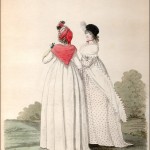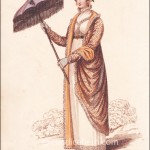Ackermann’s Repository of Arts, November 1814.
“Walking Dress.”
Note the short hem. This is the year when Walking Dresses finally became shorter, after years of hems dragging the ground, no doubt requiring frequent laundering. A few years prior, we start to see the term “walking length” for outdoor dresses, and those were certainly shorter than the decade earlier when even walking dresses had trains, but this new length was still only an inch or two above the ground. By 1814, the hems are shown much shorter, as here.
Long over-the-elbow gloves were worn with day dresses if those dresses had short sleeves, as shown here. If you browse through the Walking Dresses on this site, you will see no British prints with short sleeves and short gloves with day wear. It is always long sleeves with short gloves or short sleeves with long gloves. It must not have been quite the thing to show bare arms during the day in Britain. French prints, however, often show bare arms during the day.
The print is described in the magazine as follows:
“An Italian striped sarsnet lilac-colored dress, ornamented round the bottom with a double quilling of satin ribband; short full sleeve, trimmed to correspond; the fronts of the dress cross the bosom and form an open stomacher; a Vandyck French ruff, and full bordered cap to correspond. The satin straw hat, tied under the chin with a check or striped Barcelona handkerchief, crossing the crown with a small plume of ostrich feathers in the front. French shawl, a white twill, embroidered with shaded scarlet and green silks, and fancifully disposed on the figure. Gloves Limerick or York tan, drawn over the elbow. Half-boots of York tan or pale buff kid.”








